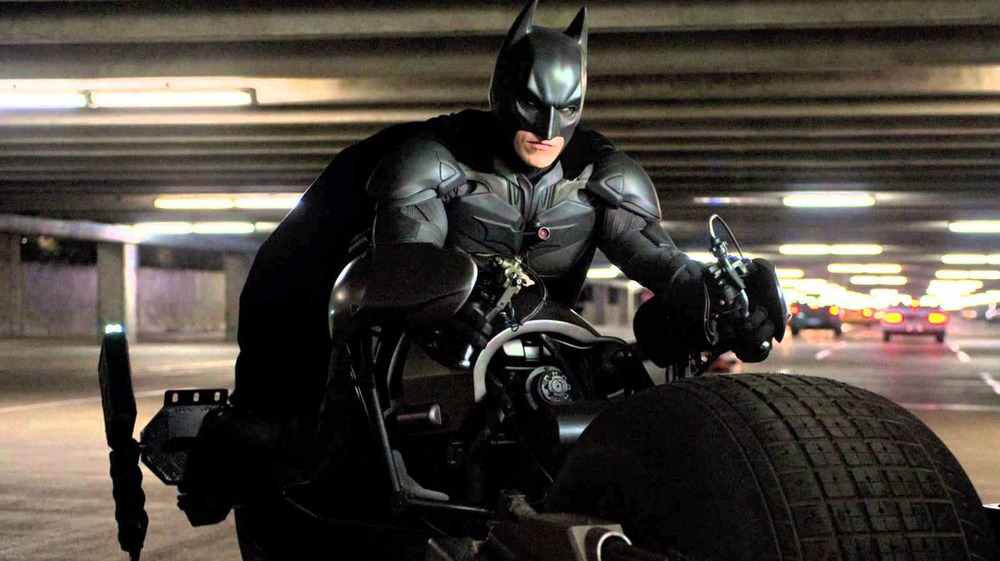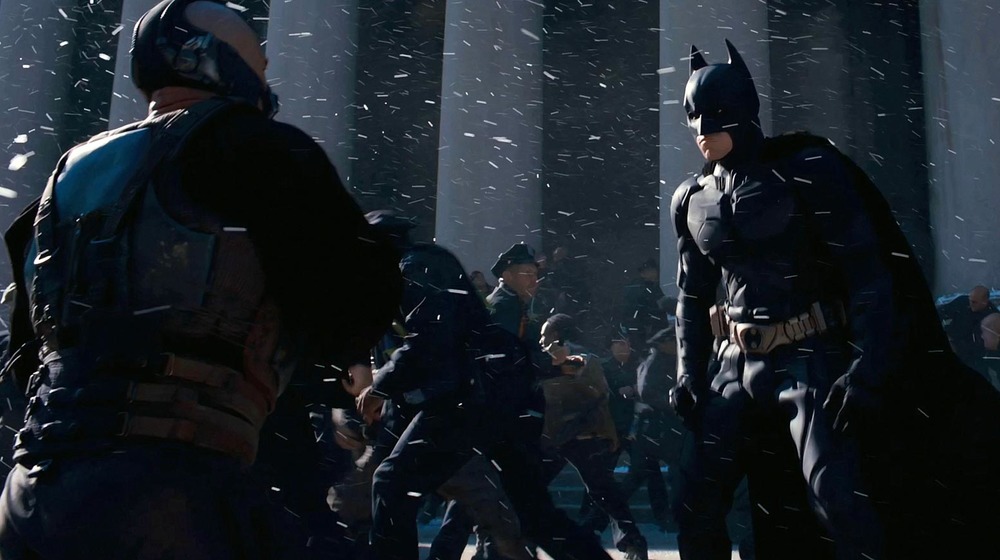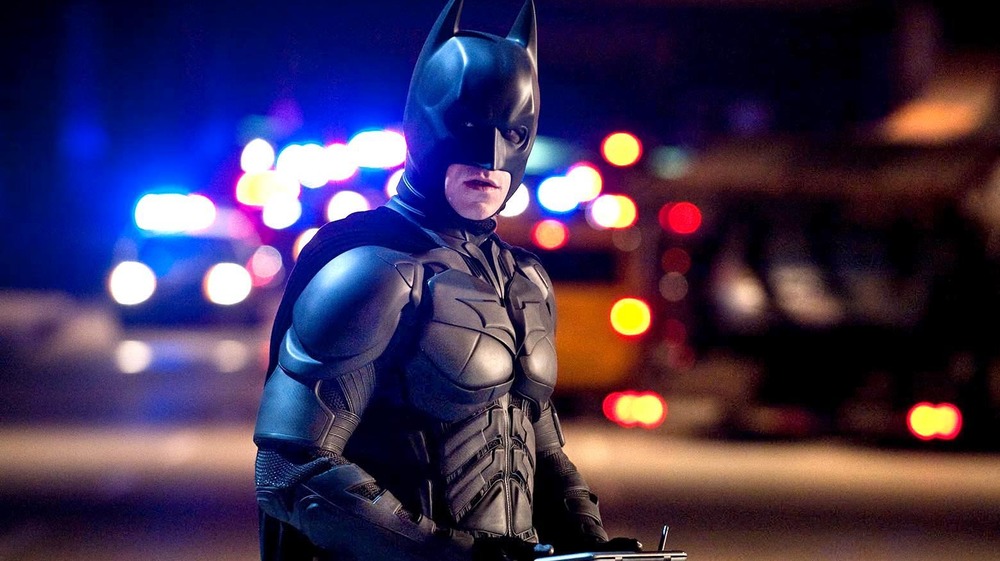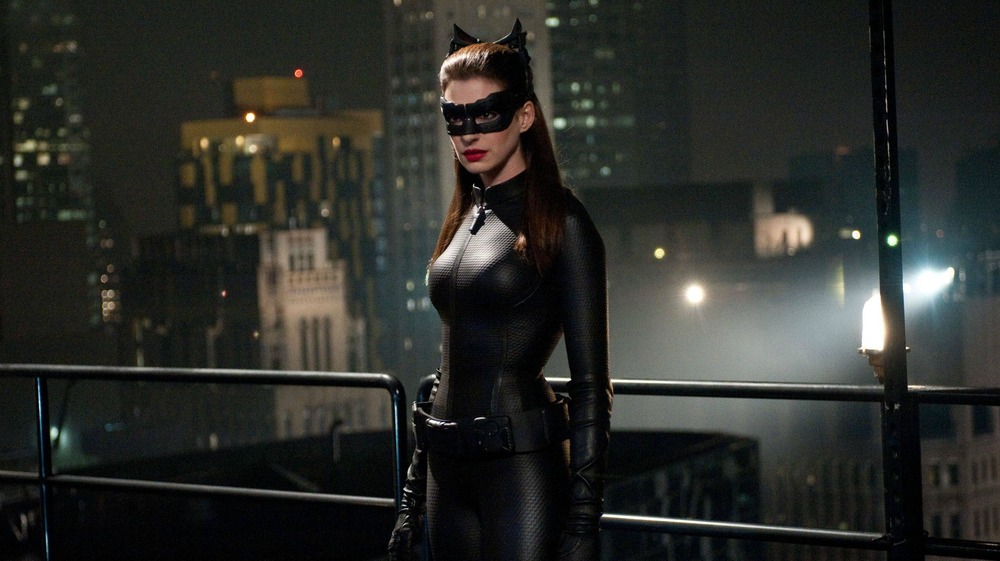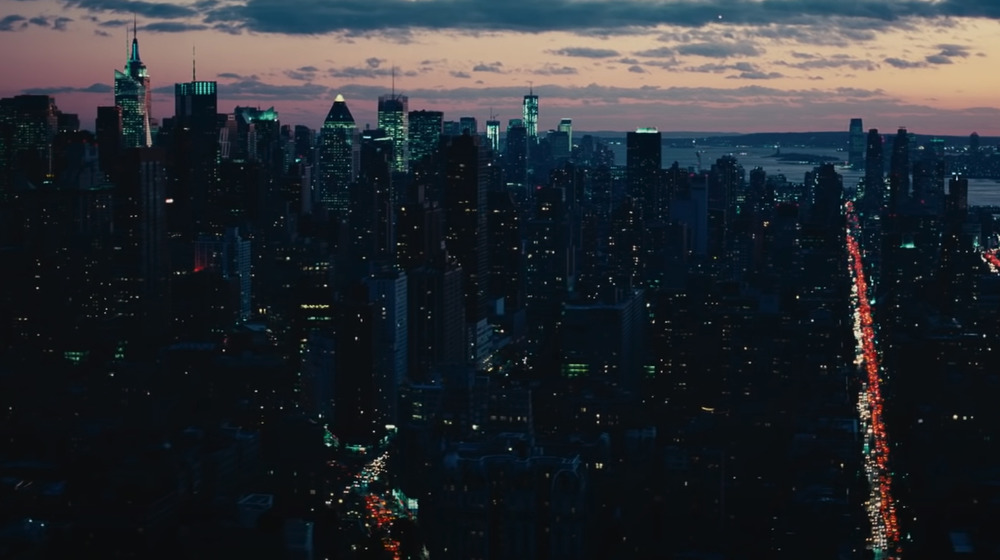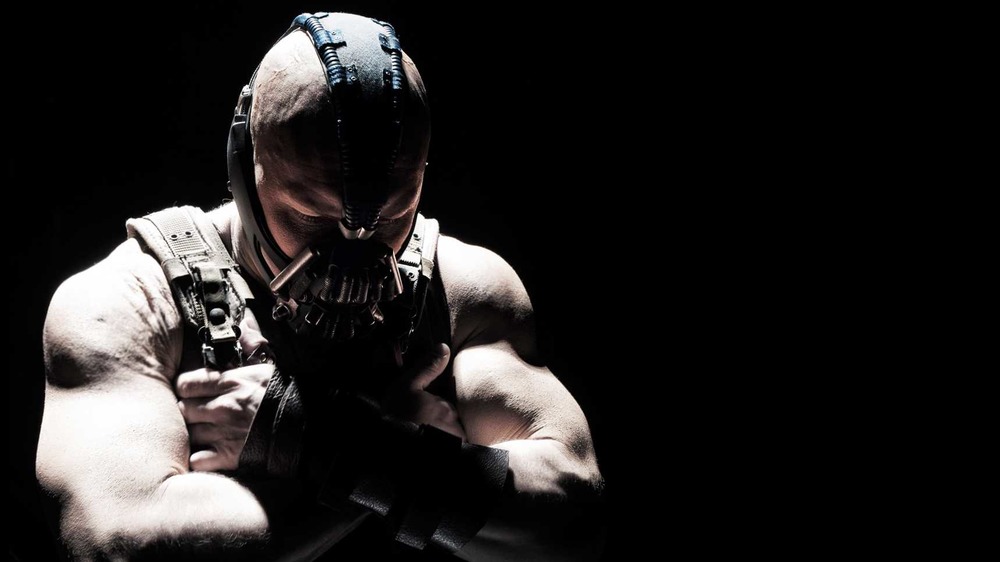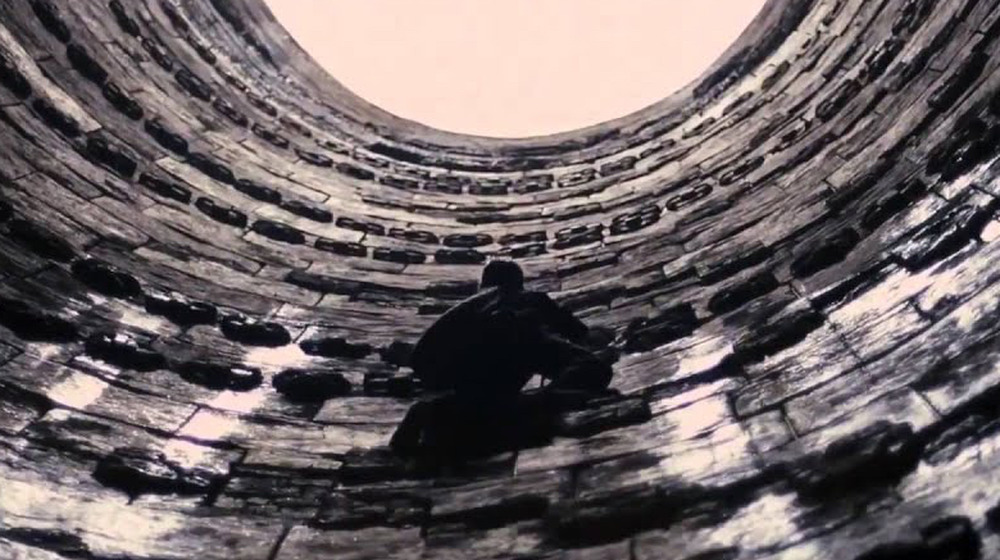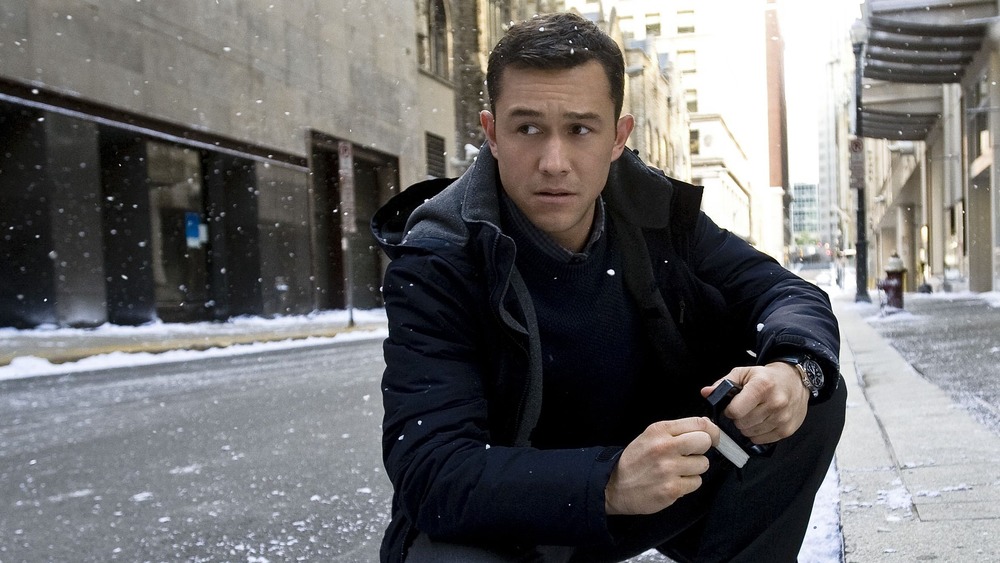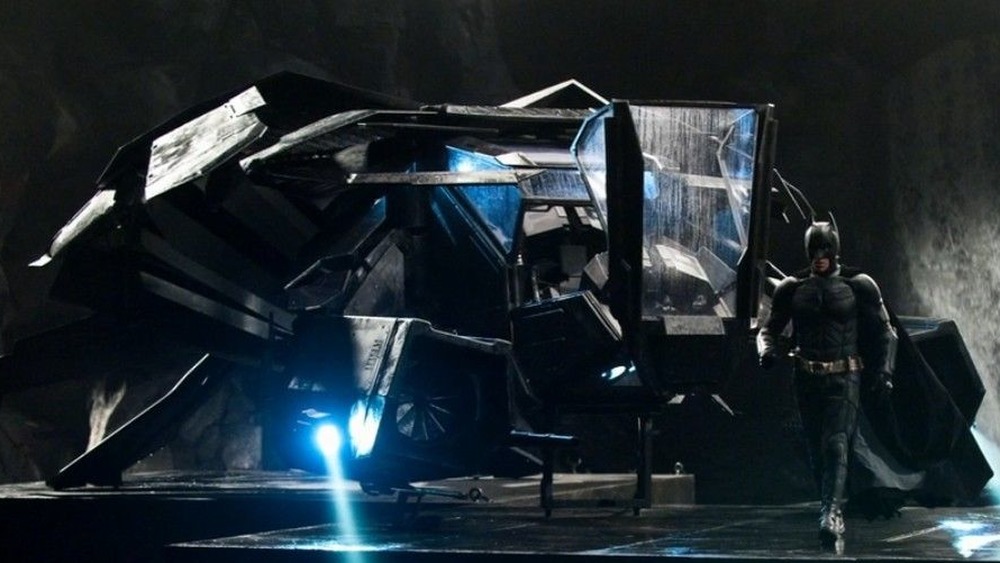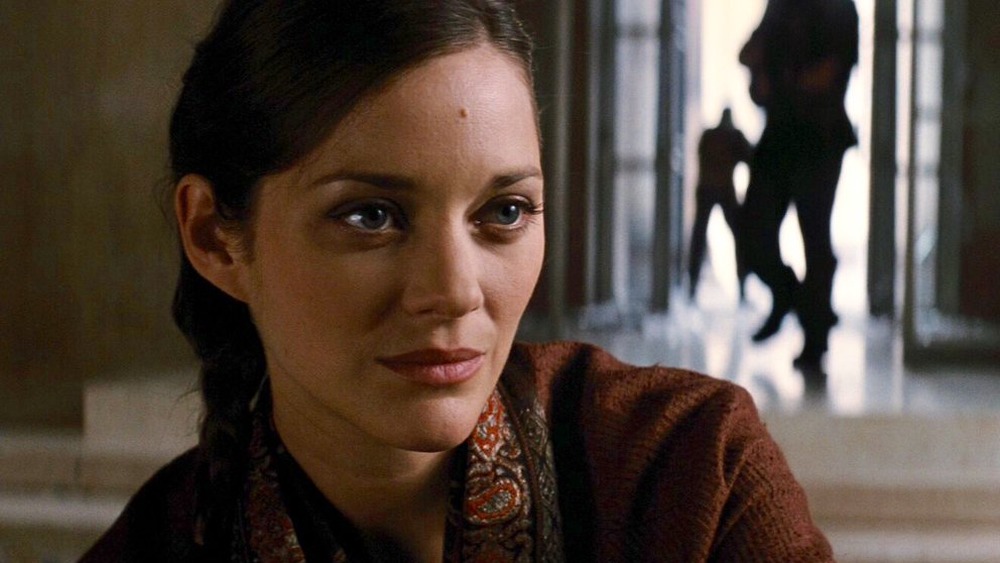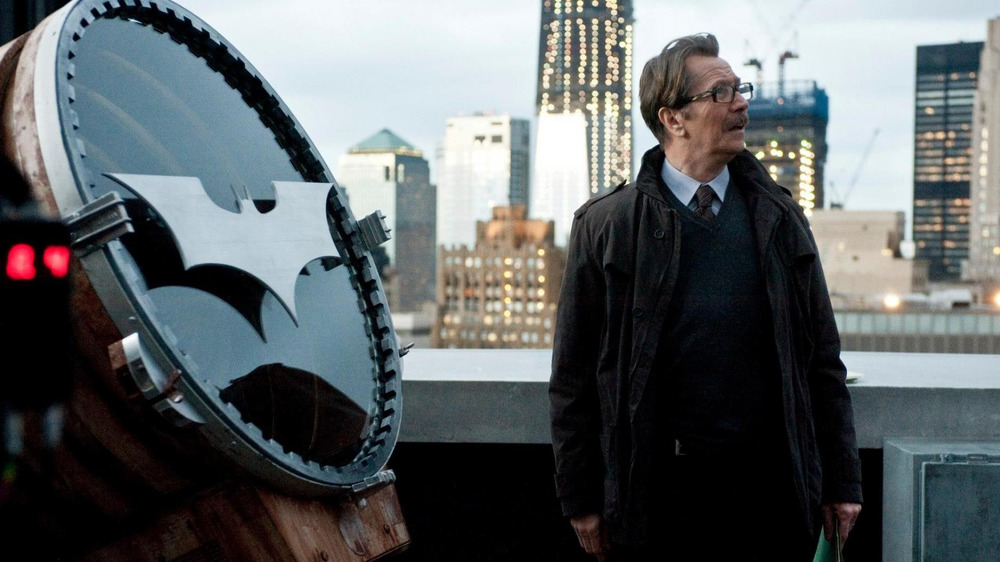Why The Dark Knight Rises Is The Best Of The Dark Knight Trilogy
We may receive a commission on purchases made from links.
Many fans and critics agree that Christopher Nolan's Dark Knight trilogy remains the peak of comic book cinema. Yes, there are other excellent candidates — the original Superman, Iron Man and Logan all come to mind. But as a whole, given the artistry on display, the storytelling, the sense of realism Nolan achieves, and the sheer awe-inspiring scale, you can make a strong case that Nolan's contributions have yet to be exceeded. But which of the trilogy is the best? Viewers usually contend that the middle entry, The Dark Knight, is the best, and they point to Heath Ledger's Oscar-winning version of the Joker as the reason why. Yet Ledger's legendary performance looms so large over the movie that it's a bit of a surprise to realize he only has about 30 minutes of screen time. In between, Nolan crams in a half dozen subplots that don't all coalesce, even if the film overall remains stunning.
Critics weren't as high on The Dark Knight Rises as they were on its predecessor. And, admittedly, the aesthetic that Nolan created could only be fresh once. But Nolan took that aesthetic — the Michael Mann crime film style, the vertiginous swoops between skyscrapers, the enormous IMAX images — and improved upon it in the third film. At a certain point, of course, it's all splitting hairs. But hey, that's what fans love to do! So below we make a case for The Dark Knight Rises as the best of Christopher Nolan's Batman trilogy.
It has the most epic scope
Christopher Nolan is nothing if not ambitious. Especially once he had the budgets, his films began to attain ever more extravagant heights, both visually and narratively, often with three of four plots squeezed into one film. That's certainly the case with The Dark Knight Rises, which interlinks the major stories of Bruce Wayne/Batman, Selina Kyle, Bane, Talia al Ghul, and John Blake with minor subplots involving Commissioner Gordon, Alfred, and many others. As with The Dark Knight, some of this material gets short shrift, and some of what could use more leisurely attention flies by too quickly. Eliminating a subplot or two could have streamlined the filmmaking.
But Nolan knows that a showman must continue to ratchet up the scope and the stakes for the audience, saving the most astounding material for last. The director compared the production of TDKR to D.W. Griffith's monumental silent epic Intolerance, still one of the most ambitious and elaborate productions ever undertaken. Like Griffith, Nolan gambles that audiences prefer more imagination and daring, not less, even if the result is not always the smoothest experience. The Dark Knight Rises can also be thought of as Nolan's Götterdämmerung, the final opera in Wagner's epic Ring cycle. It means "Twilight of the Gods," and imagines the crumbling of Valhalla. Nolan and his enormous cast and crew deliver a crumbling Gotham, with our contemporary gods — superheroes and supervillains — locked in mortal combat on the largest possible stage.
It features the most stunning cinematography
Christopher Nolan's films are known for their cinematography. As the director was emerging in the late '90s and early 2000s, his movies stood out for their stunning shots and evocative atmosphere. A movie like Insomnia may have a somewhat conventional plot, but Nolan's team captures a vast and rugged Alaska. As his career progressed and his budgets ballooned, his films became epic in scale. Like the films of other top directors — Quentin Tarantino, James Cameron — a Christopher Nolan picture became an event not just for the content, but for the filmmaking itself and the innovations in IMAX or the use of 70mm film. This was true of The Dark Knight, which blew audiences away with its towering IMAX photography and cinematic realism.
Perhaps because critics and audiences were so enamored with the visual qualities of The Dark Knight, they overlooked that The Dark Knight Rises is arguably a more impressive visual achievement. This is not only one of the most epic movies ever shot, it's one of the most beautiful, from its opening sequence of a mid-air hijacking, to the neon pulsing of police lights as they chase a re-emergent Batman through Gotham, to the extreme long shots of Gotham's bridges blowing up in sequence. And it's not just the massive exterior scenes either. The Batcave and Bane's underground tunnels are a shivering watery blackness; the high society scenes have a burnished glow; and Bane's prison pit is stark and desolate.
Anne Hathaway is purrrrfect as Selina Kyle
Some moviegoers take issue with Anne Hathaway, which is inexplicable since she is undeniably awesome. She's got the charisma and she's got the range. Check her out in a complicated character study like Rachel Getting Married, or as the only remotely entertaining element of the dreck that is Ocean's 8. As Selina Kyle, a.k.a. Catwoman, she brings all that and more to The Dark Knight Rises. She's funny, glamorous, and seductive when manipulation is called for. She also nails the athleticism required of the role. But the main appeal is that Hathaway plays Selina as though she doesn't give a f*** and is solely out for herself, when deep down she really cares. She even gets a Han Solo moment during the film's extended climax, when she returns to save Batman. As someone who legitimately hates the rich and who is completely on board with wealth redistribution, she is a more successful embodiment of Nolan's indictment of the 1% than Bane, whose motives run towards anarchy. Bane wants everyone to suffer, while Selina is perfectly happy just taking down the wealthy.
Playing the Joker has become a barometer for interpretive acting, with many of the versions becoming among popular culture's favorite performances. Between Michelle Pfeiffer's delicious take on Catwoman in Tim Burton's Batman Returns and Hathaway here, there's no reason we can't establish a canon of performances for this character too. No pressure on Zoë Kravitz in the upcoming The Batman!
Gotham City is grander
Chicago was an inspired choice to play Gotham City in Batman Begins and The Dark Knight. Nolan and Warner Brothers wanted a makeover for the Batman universe and that included fresh digs for Gotham, which the original Batman creators loosely based on New York City (whereas Tim Burton's Gotham owed much to Fritz Lang's fictional Metropolis). But Nolan filmed Batman Begins on several Chicago locations, and used even more of the Windy City for The Dark Knight, including iconic spots such as Daley Plaza, the Chicago Post Office, the erstwhile Sears tower, and the Chicago Theater. The extensive use of these real life locations gave the Gotham of the trilogy's first two entries a distinct flair and a fresh cinematic presence.
But when you want to really go epic — especially with aerial and long shots that capture a huge metropolis — only New York City will do. The city and its famous stock exchange were also thematically relevant to the plot about Bane's crusade against corrupt and greedy Western societies, which is why the Manhattan financial district plays a crucial role in several major sequences. The Queensboro Bridge is also featured heavily. But the Big Apple was one of many worldwide filming locations for The Dark Knight Rises, which also lensed in Los Angeles, India, London, Scotland, and Pittsburgh (including Heinz Field and the famous imploding football game.) The many global locations help give the final film of the trilogy an appropriately grand scale.
Bane is a great (and empathetic) villain
In some ways, playing Bane was a no-win proposition for Tom Hardy. He was never going to achieve the legendary status of Heath Ledger's Joker, no matter how great a performance he put in, although that certainly wasn't from lack of trying. Hardy famously put on muscle mass for the film that was more than his body could handle. He was willing to hide his handsome face (not that it seems to be a problem for him) and his voice was an instantly controversial choice. But every decision works. Bane is powerful, threatening, creepy, and exudes a fanatic's devotion to his cause that only a lifetime of suffering could instill. He also looks fantastic in a trench coat. When he famously tells Batman, "You think darkness is your ally. But you merely adopted the dark; I was born in it, molded by it," we believe the Dark Knight is in trouble.
But there is a crucial element of Bane that makes him empathetic, where the Joker, because of his murderous psychopathy, could never be: he feels both pain and love. Nolan has said that Bane's mask is a device for continuously pumping anesthetic into his body to numb pain from unspeakable injuries he long ago endured, and Hardy makes us feel the weight of Bane's tragic life. He may not reach the artistic heights of Ledger, but even Nolan has said that Hardy's fantastic performance will be more fully appreciated over time.
The pit sequence is inspiring
If the Dark Knight is going to rise, he needs somewhere to rise from, both physically and metaphorically. In the film's first half, Batman has disappeared, and Bruce Wayne is a recluse hiding out in his mansion. Batman/Bruce took the fall for D.A. Harvey Dent's murder in the previous film so that Dent could become Gotham's martyred saint. Bruce also still mourns his former love, Rachel, and blames himself for her death. And finally, he's physically not the man he used to be. Of course, when Bane starts stirring things up, Batman returns to stop him, but it seems Alfred was right when he cautioned Bruce to stay retired. Batman is much diminished, and Bane defeats him both physically and spiritually, breaking his back and exiling him to the Pit, a dungeon fortress halfway across the world where he will be forced to watch Bane destroy Gotham, as Ra's Al Ghul once hoped to.
Bruce tries and fails several times to escape the Pit in a daring climb and leap. But why does he fail? Not because he fears death, but because he doesn't fear death. Without a sense that he has something to lose, he'll never take the leap seriously enough. This sequence, imbued as it is with Eastern mysticism, has overtones of Jedi philosophy. And indeed Bruce must "unlearn what he has learned." But taking its inspiration from other texts doesn't make Bruce's ultimate escape from the pit any less triumphant or exhilarating.
Joseph Gordon-Levitt plays a terrific 'Robin'
Given how successful Batman's transition from page to screen has been, it's curious that Robin, whose various versions (Dick Grayson/Nightwing, Jason Todd) are so prominently featured in the comics, hasn't made a similar transition. Maybe it has something to do with those elf shoes, or the green short shorts, but it seems as though only the campy versions of Batman — the '60s TV series, and Joel Schumacher's neon-obsessed '90s entries — have featured the Boy Wonder. Given the critical and popular failure of Batman and Robin, it was a shrewd movie to leave Robin out of the first two Nolan movies. The franchise's cred had to be re-established before Robin could return.
Even then, it's very tentative. The "Robin" of The Dark Knight Rises is John Blake (Joseph Gordon-Levitt), so committed to his work as a Gotham street cop that he actually protests when Commissioner Gordon promotes him to detective. Coming off a substantial role in Nolan's blockbuster Inception, Gordon-Levitt was a natural fit for a key role here, and he makes a strong impression as a committed hero. The movie hints throughout that Blake may eventually become more than just a cop: he knows Batman's true identity, and like the Robin of the comics, he's an orphan. Once he discovers the Batcave, we realize it's only a matter of time before he starts doing superhero work, although eight years later a Robin movie set in the Nolanverse has yet to be announced.
The 'Bat'
Among the elements of the Batman universe that have made it so popular are the badass vehicles. Tim Burton's contributions to Batman lore in the form of the immensely popular 1989 Batmobile (with its distinctive jet turbine nose intake) and the Batwing, immortalized against the full moon, can't be underestimated. The Nolanverse leaned into the military tech of the Bat vehicles to give them a more realistic context. The first iteration of this was the Tumbler, so memorably deployed in Batman Begins and used again in The Dark Knight, along with the shiny new toy that sent fans into palpitations: the Batpod, no more than a seat and dual cannons mounted to giant wheels that wouldn't be out of place at a Monster Truck rally.
The Tumbler is gone from The Dark Knight Rises, but the Batpod gets plenty of action — the filmmakers recognize a good thing when they have it. The new toy, aptly named the "Bat" by Wayne Enterprises tech guru Lucius Fox, may not be as sleek as the Batwing, but it's better suited to urban operations (the Joker takes down the Batwing in Burton's movie with one pistol shot, after all). The Bat, on the other hand, works like a helicopter and a plane. Its maneuverability allows Batman to escape the police at the climax of the movie's most sensational sequence. And it plays a major role in the exciting climax as the good guys race to save Gotham from Talia al Ghul.
It contains a great twist/revelation
As many fans and critics have suggested, The Dark Knight Rises is a bit muddled politically. In the wake of the global financial crisis, the film echoes the Occupy Wall Street movement and attacks the hypocrisy and the greed of the one percent (not easy when you're making a billion dollar-grossing movie about a famous fictional billionaire), but it also argues that law enforcement should do whatever is necessary to put down terrorism and social disorder. Yet, while it may not be the sharpest political allegory, it works at an emotional level. That's largely because of the revelation that Miranda Tate (Marion Cotillard) is actually Talia al Ghul — daughter of Ra's al Ghul, Batman's mentor and former leader of the League of Shadows — and that Bane is not the child who was born in and escaped the pit. Talia was that child, and Bane protected and saved her at great cost to himself.
This twist serves the narrative in three major ways. It reveals the hidden villain behind the plot to destroy Gotham. It makes Bane into a sympathetic figure, one who both loves and is loved. And it ties the trilogy together, as we understand in a rush of insight going back to the first film why Talia has used Bane to construct such an elaborate plot. Talia may pretend to be a political anarchist like her father, but her real motive is much baser: vengeance against Batman for his death.
It provides rare closure
Closure is a dirty word in the era of entertainment conglomerates' insistence that every film or TV property be capable of generating scores more. True to form, following in Disney's Goofy-sized footsteps, Warner Brothers just announced a proliferation of DC properties stretching into the foreseeable future. For Nolan to end his historically profitable Batman franchise at a mere three films seems like the height of artistic principle. A mere eight years later, it's doubtful that even a filmmaker of Nolan's power would be allowed to privilege the needs of the story over the studio's bottom line.
Still, what actually happens at the climax of The Dark Knight Rises remains a much-debated mystery. Batman flies the Gotham-threatening atomic bomb miles out into the ocean, seemingly sacrificing himself to save the city. And yet, in the denouement, Bruce turns up at the Florence cafe where Alfred hoped to one day see him. Is he real (saved by a late-installed automatic pilot in the Batwing) or just Alfred's imagination? The details aren't as important as the emotional closure the film gives viewers. Bruce Wayne's growth and experiences in the movie (especially in Bane's pit) finally allow him to find a life beyond Batman, as well as love with Selina after the loss of Rachel Dawes. Meanwhile there is a hero's funeral for Batman, the rise of a new hero in "Robin," and of course a shiny new Bat signal to herald Gotham's promising future.
